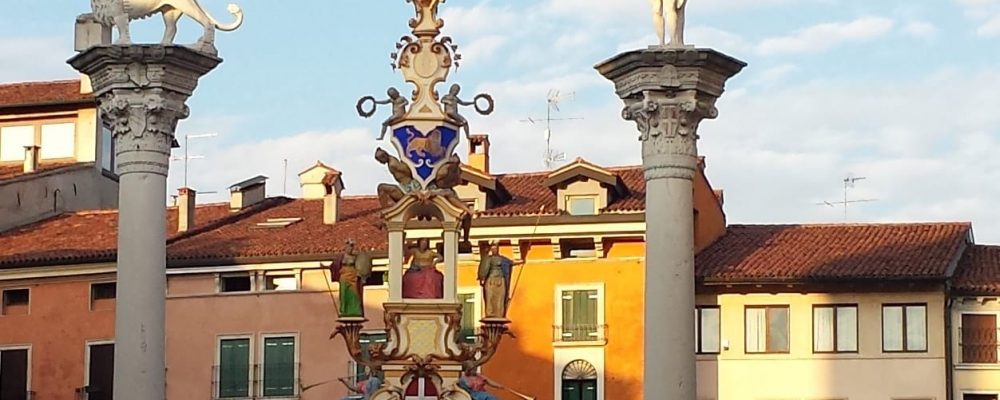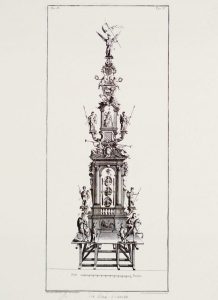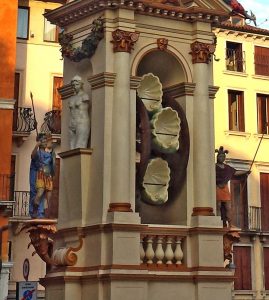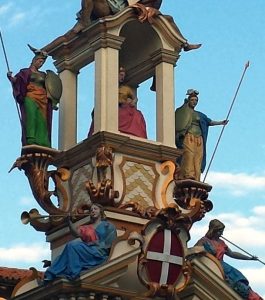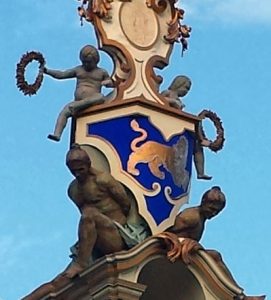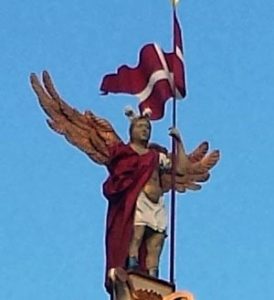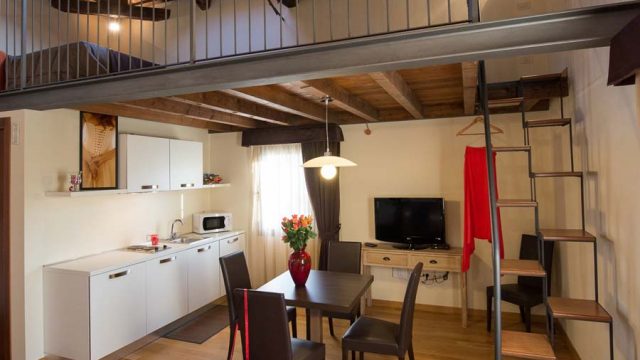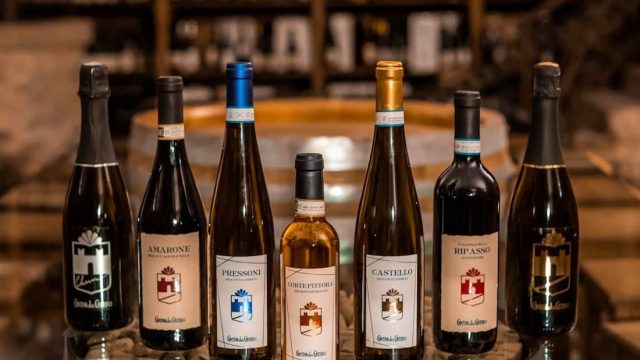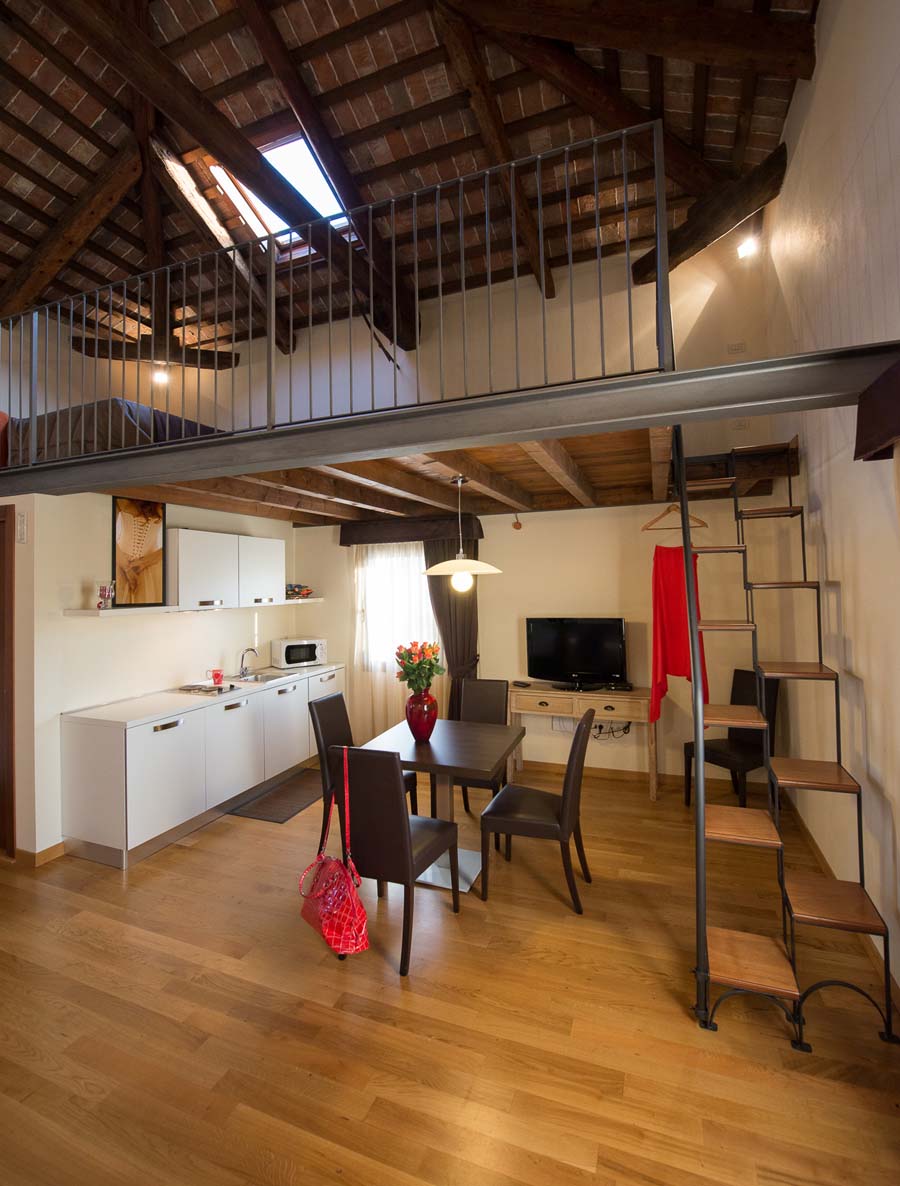Year 1263, in Bolsena in Central Italy, a Bohemian priest (whom tradition calls Peter of Prague), saw a host bleed several drops of blood while he was saying mass, a miracle that put an end to his doubts about the transubstantiation of the bread and wine into the body and blood of Jesus Christ.
A year later, to commemorate the event, Pope Urban IV established the feast of Corpus Domini, which is celebrated on the Thursday after the Octave of Pentecost, “making universal” a practice that he had already seen and admired in Flanders. Unfortunately, the Pope died that year and his successors did not promote the feast as actively, interrupting its observance for about forty years.
This is why it is not mentioned in the Vicenza Statutes of 1264 but it appears in the Statutes of 1311, when it was decreed that “Every year there will be a solemn feast on that day to honor and venerate the Most Holy Sacrament with a solemn procession of all the clergy, the guilds and the arts, which must attend with their insignia, pallium and lit candles. The colleges of judges and notaries must also attend, with their multicolored hoods and a lit candle or two-branched candlestick.”
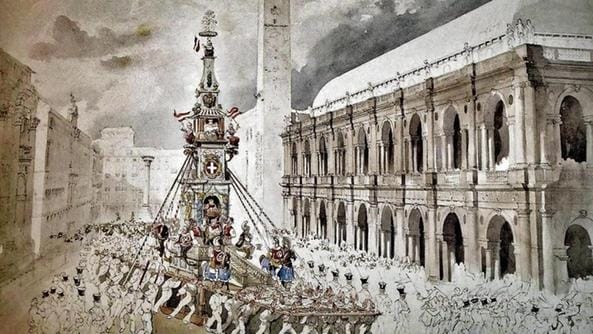
Year 1389, the Corpus Domini procession in Vicenza became a true and proper “city festival” and there are reports that the College of Notaries participated in it with great pomp as early as 1390. The order of march in processions was established when the Statutes were renewed in 1425: in the parade, the Precones of the Municipality and the Berodieri of the Mayor and Captain – i.e., the civil and military authorities that had represented Venetian domination for the last twenty years – must be followed by the Rector and the councilmen ad utilia, the College of Judges, the Notaries and then all the others. So, the Notaries (or Nodari) were assigned a position of prestige; so much so that, in 1441, they appointed four of their members to come up with “something new” that would make the College “look good” in the procession in place of the traditional cirio (candle).
With the help of Master Giorgio – a painter who had a workshop in Contrà Do Rode – they made a new banner portraying the Madonna, San Luca and four angels. Three years later, they wanted to do even better and so Master Giorgio invented the “machine”, or Rua (wheel).
Figuratively also recalling the Tarots that were popular throughout Europe in those years, the artist adds the cards typical allegorical figures to the decorations of the wood structure and placed the Notary’s professional insignia, the wheel, in the central part of the “machine”. The College of Notaries was preceded by the Ruota in the Corpus Domini procession of 1444 and it was a huge success.
Some have given credit for the invention of the Rua to Palladio: but when that great architect was at the height of his career, the Rua was already a hundred years old! It is certain that, on various occasions, he contributed to decorating it to welcome some illustrious person to Vicenza and it can’t be ruled out that he might even have helped “enhance” the Rua that was displayed.
According to some of the most colorful local traditions, especially from the 19th century, the Rua is said to commemorate a battle that Vicenza won against Padua in the 13th century: in particular, the conquest of a wheel of the enemy’s Carroccio (a military cart with a tower and standards of the city). But, as we have seen, the historic reality is that the Rua originated as the symbol of the College of Nutaries for the religious procession of Corpus Domini. Then, in just a few decades, it went on to become a popular emblem for the entire community of Vicenza.
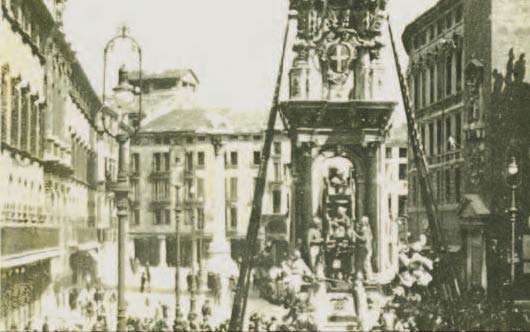
But why is the center of the icon a wheel? At this point, we need to explain that the Notaries were divided into Modulanti and Vacanti.
The first, 300 in total, were divided into five sections and succeeded each other in positions by rotation. It was this periodic “turnover” that suggested the motion of a wheel and gave rise to the College’s symbol. Subsequently, the wheel in the structure of the “machine” became a sort of vertical carousel with seats for a few children.
The Rua was immediately very popular and every important Vicenza event (and not just Corpus Domini) became an occasion to pull it out of the warehouse, or rebuild it from scratch, decorated with an increasing number of live or Papier mâché figures.
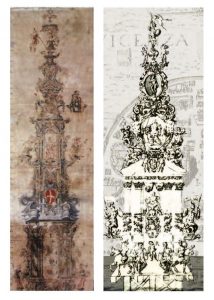 Over the centuries, royal visits, illustrious persons passing through and newly arrived bishops were welcomed by a display of the Rua, sometimes just parked in places of particular scenic effect. The Municipality asked the Notaries to display it and they soon began to complain about the expense until, in 1483, they decided not to display it anymore without a high fee for its restoration.
Over the centuries, royal visits, illustrious persons passing through and newly arrived bishops were welcomed by a display of the Rua, sometimes just parked in places of particular scenic effect. The Municipality asked the Notaries to display it and they soon began to complain about the expense until, in 1483, they decided not to display it anymore without a high fee for its restoration.
When the problem arose again a hundred years later, the City decided to take-over the Rua, paying the purchase price of five hundred ducats with the help of the nobleman Pietro Paolo Bissari. This is why 1585, the first year the Rua was displayed as a public spectacle and not a private emblem, was also the first year of the popular salute, “Viva la Rua di casa Bissara!” with which the figures and the people expressed their gratitude.
In any event, its transformation into a generally “secular” symbol of the city contloued. In fact, starting in 1616, the tower began to turn only at the end of the Corpus Domini procession, because the ecclesiastical authorities didn’t like the fact that the crowd was more eager to the passage of the Rua than the Most Holy Sacrament.
As time passed, the dimensions of the “massive structure” became more and more imposing until it was more than 24 meters high and weighed eighty quintals. For this reason, the number of porters “mobilized” to pull it grew to eighty.
The Rua was assembled in present-day Piazzetta Palladio and then dragged along a route through the old town center that immediately became canonical: from Piazza dei Signori through Contrà Muschieria, Piazza Duomo, the Vescovado, Piazza del Castello and then the Corso to the turn for Contrà Santa Barbara and then the “triumphal” return to Piazza dei Signori.
As the crowds of local and foreigners grew, so did interest in the Rua as a social phenomenon, as a “collective passport” to a day of authentic carousing, and the number of reports from the Italian newspapers. Precisely because every “appearance” triggers a series of popular celebrations. it could even provide some interesting ideas about customs and folklore.
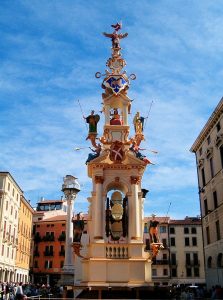
Di Marcok / it.wikipedia.org – Opera propria (own photo), CC BY-SA 3.0, Marcok
It is also obvious that a symbol of this power is also loaded with political significance; during the French occupation, the original Lion of San Marco on the Rua was replaced with characteristic French Cock, with the cartouche, Liberty and Equality. The Austrians imposed the two-headed Hapsburg eagle and, after the Veneto was united with Italy (1866), ut took on the colors of the Italian flag and the coat-of-arms of the House of Savoy.
It’s worth noting that the last “normal” route, which is to say, through Muschieria, Piazza Duomo, Piazza del Castello and the Corso to Santa Barbara, was followed in 1901, when the self-propelled tower was no longer part of the Corpus Domini procession, but was one of the attractions of Settembre Vicentino. Eleven years later (1912), the Rua was pulled only to Piazza d
ei Signori and Piazza Biade, since the streets of its route were now filled with the wires of the street lamps, telegraph and trams.
It made its last appearance in 1928 accompanied by Fascist banners. Then, it was dismantled and stored in the “leprosarium” in the hamlet of Gogna, where its was completely destroyed by repeated aerial bombing during World War II.
Original text by Walter Stefani – Historian and memorialist of Vicenza.
Courtesy of the Comune di Vicenza, original pdf brochure here.
The Rua nowadays
On 1949 it has been built a small scale reproduction, called Rueta, 400 kg and 8 meters high. On May 3, 1949, and later on 1981, the Rueta was paraded through the city streets.
On 2007, the AIM – AMCPS company rebuilt the Rua of Vicenza in its size and features of the sixteenth century, 24 meters high and a total weight of 300 quintals.
The new Rua was exhibited annually between 2010 and 2013, and the traditional procession was also re-opened along the original Rueta route.
Since 2015, the Giro (the parade) is held biennial in odd years with an European value .
The current parade is headed by the recently restored Rueta, featuring a cascade of white and red flowers, the colors of the city. To support it, in turn, there are 18 vicentine athletes accompanied by the rhythm of the historic alpine fanfare.

